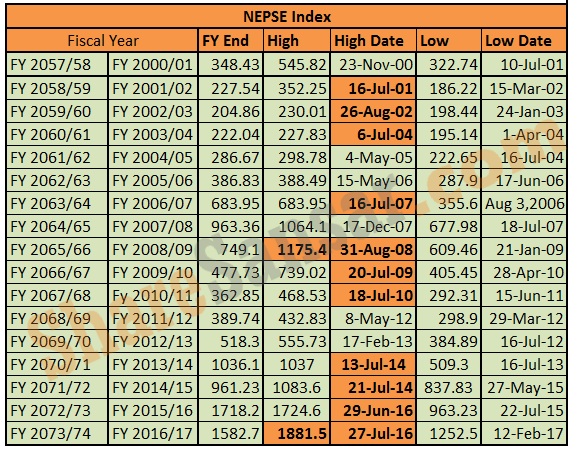Will NEPSE create one more yearly peak in the coming two months?
Wed, Jun 13, 2018 11:23 AM on Exclusive, NEPSE News, Latest,
Last sixteen years have been sole evidence for the creation of majority of highs in between July and August. From FY 2000/01 to FY 2016/17, there were 11 highs that were created within the months of July to August. Smart players build a strategy to invest during the lows of May and June while profit with the highs of July and August. The table below provides an evidence of which year created the highs in July and August.

Past two bulls in 2008 and 2016 were also created in the months of August and July with an index of 1175.38 and 1881.45 respectively. If we look the other side, majority of lows were also created prior to July and August. So, this can be an opportunity for investors to grab the profit as much as possible.
There are three major reasons attributed to the bulls in July- August.
- Publication of fourth quarter report
- Dividend declaration
- Optimism created by budget announcement and monetary policy
- People hold no interest burden of BFIs
- Flow of money into the banking system due to last hour government spending
Every investor invests with an objective to maximize their wealth. In the month of August, majority of companies publish their fourth quarter report. The publication of such financial reports is both evidence of a company’s financial status throughout the year. Investors take several investment decisions through analysis of these quarterly reports during the month. Hence, a number of optimist investors emerge out in the market with a hope to maximize their wealth by observing the quarterly reports.
Along with the financial reports publication, companies also declare dividends to the investors. The dividend consumption is one of the primary motives behind the investment by Nepalese investors.
Monetary policies published by central bank targets inflation rate or interest rate in order to ensure price stability and general trust in the currency. With the continuously rising interest rates, general public have hopes of interest rate stability from the NRB. If the monetary policy will be able to promote public confidence, the stock market is likely to have a bullish period in July and August.
Budget announcement usually introduces new policies in the country. National budget of the country is announced within June. This adds enthusiasm among investors. Besides, secondary market of Nepal and economic development in interrelated with one another. So, a thoughtfully presented budget aspiring for economic development often brings positivism among investors. Unlike the past years, this year’s budget brought a lot of negativity in the secondary market.
In the last quarter of fiscal year, government concentrates on spending more of its capital expenditure. This is the time where government speeds up its entire unused budget in the construction of infrastructures and several development works. This brings money into the banking system due to last hour spending from government at the end of Ashad.
With the end of August, investors are free interest burden of BFIs. They usually settle all their interest liabilities till July/August and look for investment opportunities. The investors are, hence, under no pressure for paying off any kind of obligation in the particular month.
If we imply the principles of behavioral finance, these incidents come under “calendar anomalies” or “calendar effect”. It refers to the theories that assert certain days, months or times of year are subject to above-average price changes in market indexes. It can therefore, signal good or bad time to invest. Such anomalies have an existence in international stock market and Nepalese secondary market is no different.
There is no guarantee of a fixed return from the present or upcoming secondary market, however, investors might benefit if the secondary market functions similarly to the trend from past years. Normal investors and beginners usually prefer to invest once the market reaches the peak point. It is exactly the time when majority of investors sell their shares and loss have to be bore by the average investors. Thus, rather than making a mistake of investing when the market reaches the peak point, history shows that investing before the bulls can be a strategically right investment.
Although it can be referred July and Augusts are the months for peaks from past data, yet there are certain probabilities that might hinder the index growth this year. The CGT tax that has been increased to 7.5% might be the major hindrance in the index growth. Besides, the recent investors’ strikes have also demotivated the investors in capital market. Finally, the government under the leadership of Communist party believes in the equal distribution of resources in order to form a classless society. This motive does not align too the principles of Nepalese secondary market where investors are of speculative nature and guided by the principles of wealth maximization.
.png)
So, what the upcoming months will bring is yet to be seen. Please leave your views about Nepalese secondary market in the comments below.


